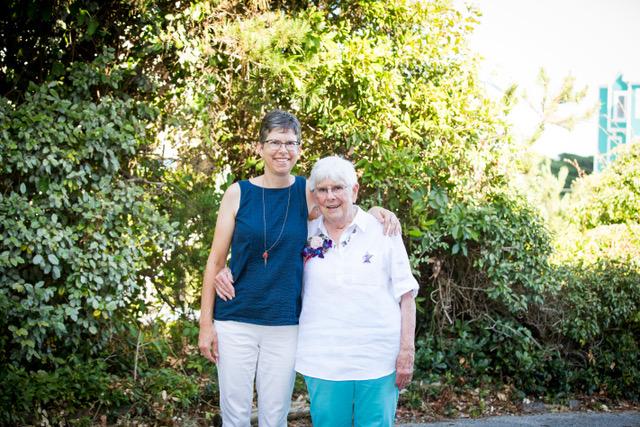
By Mary-Russell Roberson
Mary-Russell Roberson writes regularly for the Department of Medicine about aging and geriatric medicine. In this essay, she writes about how her parents Ruth and Russell Roberson took to telehealth, a new way for patients and health care providers to meet safely during the COVID-19 pandemic. Learn more about Duke's use of video visits, telephone calls and virtual check-ins. Photo by Graham Hunt.
Back in March, shortly after the the new coronavirus arrived in North Carolina and changed everything, I asked my mom if she and my dad had any upcoming doctor appointments.
As a daughter of two 89-year-olds, I often accompany my parents to medical appointments, and I didn’t relish the idea of the three of us being out and about in a bustling medical center while the pandemic was taking off.
I was relieved when she said the rest of the month was clear. However, they both had mid-April appointments with their geriatrician, Mitchell Heflin, MD, professor of medicine (Geriatrics).
Even in pre-pandemic times, medical appointments could be stressful for my parents and by extension, me. The sense of rush and hurry among other patients and providers, combined with the hassle of way-finding in a large building and taking in a lot of new information was tiring and sometimes resulted in confusion and frustration as well.
My parents’ retirement community provides free transportation to and from doctor appointments, which is a great advantage. Even so, it takes extra time, making a long day even longer.
Mid-April came quickly, and we learned that my parents had the option of seeing Dr. Heflin via Zoom. That was good news to us. My mom had already learned how to use Zoom for family “get-togethers,” and a Zoom appointment would allow me to “be present” even though I couldn’t be with my parents. (Their retirement community was not allowing visitors.)
Jamie Lamkin, who had been redeployed from a temporarily shuttered Aging Center lab, set up the Zoom room and let us in from the virtual waiting room. With my parents’ permission, medical student Priscila Cunha joined us as well.
My parents had planned months earlier to discuss end-of-life issues at this appointment. The pandemic brought an added focus to the conversation.
Dr. Heflin asked my parents some questions about what their goals might be when facing an intense medical experience. Would they want to simply survive at any cost? Or only if certain conditions could be met, like remaining independent or being of sound mind?
The screen of four squares and five faces, all looking at one another, seemed more intimate than an exam room. The space, virtual though it was, allowed and encouraged the focus, intention, and attention necessary for such a conversation.
My mom shared some stories of some older relatives whose end-of-life paths she would prefer to avoid, and some that she wouldn’t mind experiencing. My dad agreed with the general outlines she laid out.
Dr. Heflin listened, and asked questions, and shared some medically relevant information about some common end-of-life decision points, such as community resuscitation and the use of feeding tubes and ventilators.
He suggested that my parents spend some more time talking over these issues with me and other family members and then contact him again if they had questions or were ready to put some of the decisions in writing. They already have a living will, but he introduced us to some other forms they could consider filling out, such as a “community DNR” form (which would apply only if they weren’t already in the hospital) and a MOST form (Medical Orders for Scope of Treatment).
My mom asked Dr. Heflin if he could be brought in to be part of any team making difficult end-of-life choices for her or my dad during an emergency in the hospital. He said he would be honored.
Then they moved on to other parts of the visit, covering the same ongoing health issues they would have in the clinic, minus vital signs and other hands-on assessments.
At the end of the appointment, the medical student surveyed my parents about their experience of the telehealth visit. My mom said she was surprised how personal it seemed and preferred it to an in-clinic visit. And she loved not having to spend physical and mental energy getting to and from the clinic.
Dr. Heflin said he and many of his colleagues were also enjoying video visits.
“The visits feel less rushed, but they are actually more efficient,” he said.
It’s not hard for me to go with my parents to doctor appointments because I live nearby and have a flexible freelance schedule. But for far-flung families, video visits offer the opportunity to participate in an appointment they wouldn’t be able to otherwise.
Of course, not all older adults have the technology, the technological know-how, or the comfort to participate in telehealth visits. Still, Dr. Heflin said, in a separate conversation, “We’ve had to pivot hard, and I’ve been amazed at how agile these older adults are.”
Cathleen Colón-Emeric, MD, professor of medicine and chief of the Geriatrics Division, called telehealth a “bright spot in the epidemic” in an interview with the Washington Post in early May. She said, “There are actually a lot of patient-centered benefits. I think it’s actually going to really change the way we deliver health care in a positive way.”